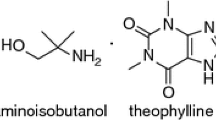Abstract
The thermal behavior of oxytetracycline hydrochloride (OTC) antibiotic was evaluated using TG–DTA, TG–FTIR and DSC. Information was obtained regarding thermal stability and decomposition steps. From TG–FTIR, it was possible to identify some of the products of its thermal decomposition as chloridric acid, water, isocyanic acid, dimethylamine, methane, carbonic gas and ammonia, and carbon dioxide from the decomposition of the isocyanic acid. According to DSC data, melting occurred concomitantly with decomposition. The TG/DTG, DTA and DSC curves, together with the FTIR spectra of the volatile decomposition products, were used to propose a mechanism for oxytetracycline decomposition.






Similar content being viewed by others
References
Bannach G, Cervini P, Cavalheiro ETG, Ionashiro M. Using thermal and spectroscopic data to investigate the thermal behavior of epinephrine. Thermochim Acta. 2010;499:123–7.
Bannach G, Arcaro R, Ferroni DC, Siqueira AB, Treu-Filho O, Ionashiro M, Schnitzler E. Thermoanalytical study of some anti-inflammatory analgesic agents. J Therm Anal Calorim. 2010;102:163–70.
Giron D. Thermal-analysis and calorimetric methods in the characterization of polymorphs and solvates. Thermochim Acta. 1995;248:1–59.
Silva ACM, Gálico DA, Guerra RB, Legendre AO, Rinaldo D, Galhiane MS, Bannach G. Study of some volatile compounds evolved from the thermal decomposition of atenolol. J Therm Anal Calorim. 2014;115:2517–20.
Giordano F, Novak C, Moyano JR. Thermal analysis of cyclodextrins and their inclusion compounds. Thermochim Acta. 2001;380:123–51.
Wesolowski M. The influence of various tablet components on thermal-decomposition of some pharmaceuticals. Mikrochim Acta. 1980;1:199–213.
Neto HS, Novak C, Matos JR. Thermal analysis and compatibility studies of prednicarbate with excipients used in semi solid pharmaceutical form. J Therm Anal Calorim. 2009;97:367–74.
Kumar N, Goindi S, Saini B, Bansal G. Thermal characterization and compatibility studies of itraconazole and excipients for development of solid lipid nanoparticles. J Therm Anal Calorim. 2014;115:2375–83.
Lira AM, Araújo AAS, Basílio IDJ, Santos BLL, Santana DP, Macedo RO. Compatibility studies of lapachol with pharmaceutical excipients for the development of topical formulations. Thermochim Acta. 2007;457:1–6.
Lvova MSH, Kozlov EI, Wishnevezkaya IA. Thermal-analysis in the quality-control and standardization of some drugs. J Therm Anal Calorim. 1993;40:405–11.
Giron D. Applications of thermal analysis and coupled techniques in pharmaceutical industry. J Therm Anal Calorim. 2002;68:335–57.
Giron D, Goldbronn C. Use of DSC and TG for identification and quantification of the dosage form. J Therm Anal Calorim. 1997;48:473–83.
Materazzi S, Curini R, Gentili A, A’Ascenzo G. TG-FTIR, DSC and ESCA characterization of histamine complexes with transition metal ions. Thermochim Acta. 1997;307:45–50.
Rodriguez C, Bugay DE. Characterization of pharmaceutical solvates by combined thermogravimetric and infrared analysis. J Pharm Sci. 1997;86:263–6.
Fulias A, Vlase G, Vlase T, Tit AB, Tit AD, Doca N. Thermal study of cefoperazone monohydrate. Rev Roum Chim. 2010;55:481–6.
Fulias A, Vlase T, Vlase G, Doca N. Thermal behaviour of cephalexin in different mixtures. J Therm Anal Calorim. 2010;99:987–92.
Jingyan S, Yuwen L, Zhiyong W, Cunxin W. Investigation of thermal decomposition of ascorbic acid by TG-FTIR and thermal kinetics analysis. J Pharm Biomed Anal. 2013;77:116–9.
Marr TR. Thermal analysis of tetracycline hydrates: 1. Preparation and identification. Thermochim Acta. 1973;5:285–91.
Mitchell JM, Griffiths MW, McEwen SA, McNab WB, Yee AJ. Antimicrobial drug residues in milk and meat: causes, concerns, prevalence, regulations, tests, and test performance. J Food Prot. 1998;61:742–56.
Maia ECP, Silva PP, Almeida WB, dos Santos HF, Marcial BL, Ruggiero R, Guerra W. Tetraciclinas e glicilciclinas: uma visão geral. Quim Nova. 2010;33:700–6.
Calixto CMF, Cervini P, Cavalheiro ETG. Determination of tetracycline in environmental water samples at a graphite-polyurethane composite electrode. J Braz Chem Soc. 2012;23:938–43.
Yildiz Ö, Unluturk S. Differential scanning calorimetry as a tool to detect antibiotic residues in ultra high temperature whole milk. Int J Food Sci Technol. 2009;44:2577–82.
Lee KC, Hersey JA. Oxytetracycline tablet formulations: preformulation stability screening using differential thermal-analysis. J Pharm Pharmacol. 1977;29:515–6.
Changa PH, Jeana JS, Jianga WT, Li Z. Mechanism of tetracycline sorption on rectorite. Colloids Surf A. 2009;339:94–9.
Fernandes NS, Carvalho Filho MAS, Mendes RA, Ionashiro M. Thermal decomposition of some chemotherapic substances. J Braz Chem Soc. 1999;10:459–62.
Toro R, de Delgado DG, Bahsas A, Delgado JM. The presence of polymorphism in oxytetracycline hydrochloride shown by X-ray powder diffraction techniques. Z. Krist Cryst Mater. 2007;26:563–8.
Li F, Li H, Guan L, Yao M. Nanocrystalline Co2+/F− codoped TiO2–SiO2 composite films for environmental applications. Chem Eng J. 2014;252:1–10.
Salcedoa I, Aguzzi GS, Bonferoni C, Cerezo P, Sánchez-Espejo R, Viseras C. Intestinal permeability of oxytetracycline from chitosan-montmorillonite nanocomposites. Colloids Surf B. 2014;117:441–8.
Nicolet EPA Vapor Phase database. Omnic 8.0 software. Thermo Scientific.
Silverstein RM, Bassler GC, Morril TC. Spectrometric identification of organic compounds. 3rd ed. New York: Wiley; 1991.
Acknowledgements
The authors are grateful to agencies FAPESP (Process: 2012/09911-3), CNPq, as well as Procontes/USP and CiTecBio/NAP’s–PRP/USP programs, for support.
Author information
Authors and Affiliations
Corresponding author
Rights and permissions
About this article
Cite this article
Cervini, P., Ambrozini, B., Machado, L.C.M. et al. Thermal behavior and decomposition of oxytetracycline hydrochloride. J Therm Anal Calorim 121, 347–352 (2015). https://doi.org/10.1007/s10973-015-4447-x
Received:
Accepted:
Published:
Issue Date:
DOI: https://doi.org/10.1007/s10973-015-4447-x




